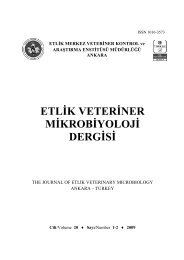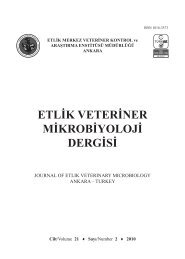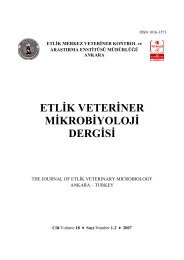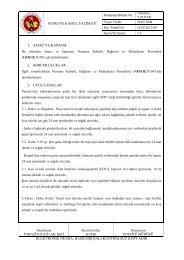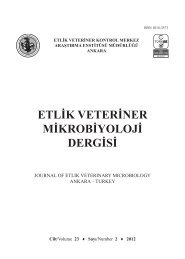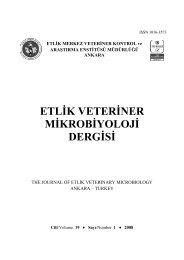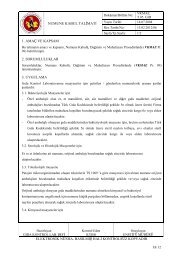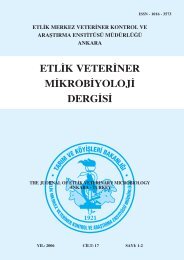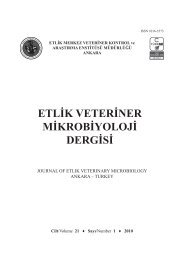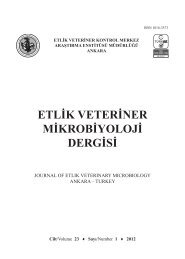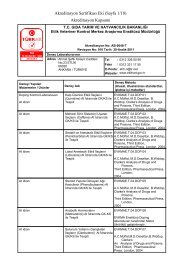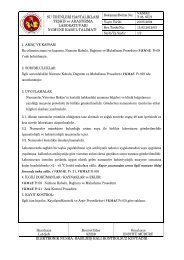etlik veteriner mikrobiyoloji dergisi - veteriner kontrol merkez ...
etlik veteriner mikrobiyoloji dergisi - veteriner kontrol merkez ...
etlik veteriner mikrobiyoloji dergisi - veteriner kontrol merkez ...
Create successful ePaper yourself
Turn your PDF publications into a flip-book with our unique Google optimized e-Paper software.
58<br />
Discussion<br />
Sırıken B ve ark. Etlik Vet Mikrobiyol Derg, 22, 54-60, 2011<br />
Enterococci have been considered as low pathogenic<br />
bacteria that infect persons with special predispositions<br />
such as immunocompromised patients.<br />
However they have been reported to be able to<br />
cause different infections, even life-threatening infections<br />
such as bacteremia or endocarditis. The Enterococcus<br />
genus comprises more than 20 species<br />
and E.faecalis and E.faecium are the most common<br />
species in foods (6, 14, 17, 23). Similiarly in several<br />
studies, different predominances of Enterococcus<br />
species, especially E.faecalis and E.faecium isolated<br />
from various poultry sources have been reported.<br />
Similar to later reports, in the present study, Enterococcus<br />
spp. was isolated from 33.3% of chicken<br />
carcasses and E.faecalis was found as the most<br />
prevalent species (42.3%). However E.faecium did<br />
not detected in any of the samples. The remaining<br />
isolates (57.6%) were evaluated as Enterococcus<br />
spp. except from E.faecalis and E.faecium. These<br />
differences in the predominance of E.faecalis and<br />
E.faecium in the poultry sources from the different<br />
areas in the world could be due to several factors<br />
such as geographic area, numbers of the analyzed<br />
sample and isolation methods.<br />
It has been reported that enterococci including<br />
also the isolates from foods had a broad spectrum of<br />
natural or acquired antibiotic resistance. Two prerequisites<br />
for acquired antibiotic resistance are 1)<br />
the genetic potential by bacteria (mutations or acquisition<br />
of resistance genes from donor cells) and<br />
2) the antibiotic selective pressure. Vancomycin, a<br />
glycopeptide antibiotic, is an important alternative<br />
for treatment of infections caused by multiple resistant<br />
enterococci as well as other Gram positive<br />
bacteria. The acquisition of resistance against this<br />
antibiotic and other glycopeptides results in dramatical<br />
decrease of the therapeutic possibilities in enterococcal<br />
infections. Thus, when considered in the<br />
medical point of view, acquired resistance against<br />
glycopeptides has a special concern (23).<br />
Vancomycin resistant enterococci (VRE) had<br />
been first reported in UK by Uttley et al. (33), in<br />
Turkey, the first VRE isolation had been reported by<br />
Vural et al. (36), in Antalya province. Following the<br />
first isolation of VRE outside the healthcare settings,<br />
from sewage treatment plants in 1993 (4), VRE has<br />
been isolated from livestock feces and uncooked<br />
chicken samples purchased from retail outlets (5).<br />
VRE have also recovered from manure samples<br />
from pig and poultry farms in Germany (21) and<br />
(11) have found VRE in the feces or intestines of<br />
other farm animals and pets, including horses and<br />
dogs. After these findings, it has been suggested<br />
that there was a relationship between the recovery<br />
of these organisms and the use of avoparcin, a glycopeptide<br />
antimicrobial drug used as a livestock<br />
feed additive in many European countries (21), in<br />
an epidemiological study (2), it has been documented<br />
that there was an association between the use<br />
of glycopeptides in animal production as feed additives<br />
and the occurrence of vancomycin resistant<br />
Enterococci especially E.faecium and E.feacalis<br />
species with high level resistance to vancomycin in<br />
farm animals included poultry and pigs. This association<br />
has been most thoroughly investigated for<br />
avoparcin-VRE association. The resistant bacteria<br />
have spread between animals in the farm environment<br />
after the selection of resistant bacteria in foodanimals<br />
by the antibiotic growth promoters (AGPs).<br />
As a consequence of the AGPs use the propagation<br />
of food animal reservoir of resistant bacteria which<br />
constitute a potential risk for spreading to humans<br />
by food intake and animal contact has occurred.<br />
Both the spreading of the resistant bacteria from<br />
animals to environment and the presence of these<br />
bacteria in food chain have been considered as key<br />
determinants for spreading to humans (37). Because<br />
the vancomycin resistance gene clusters have been<br />
found as similar or identical in enterococci of human<br />
and animal origin (38), VRE and vancomycin<br />
resistant determinants have been considered to be<br />
able to spred from animals to humans (37). After the<br />
revealing of the avoparcin-vancomycin resistance<br />
association, the use of all AGPs including avoparcin<br />
and the classes used also in human medicine has<br />
been banned in 1997 by European Union. In Turkey,<br />
the use of avoparcin and some other feed additives<br />
has also been banned by government in 1999 (1).<br />
Denmark and Germany had already forbidden the<br />
use of avoparcin in 1995 and 1996, respectively.<br />
After the ban, the prevalence of VRE in poultry<br />
decreased from >80% in 1995 to



